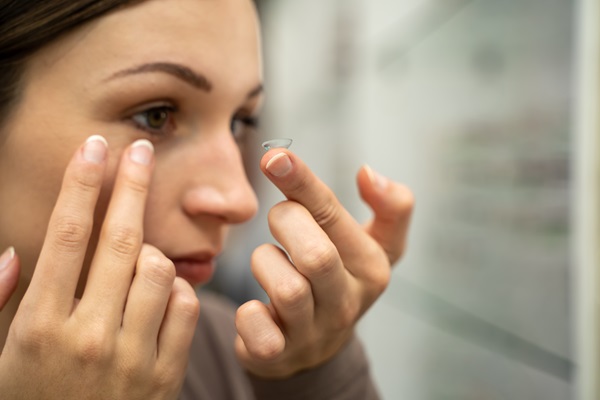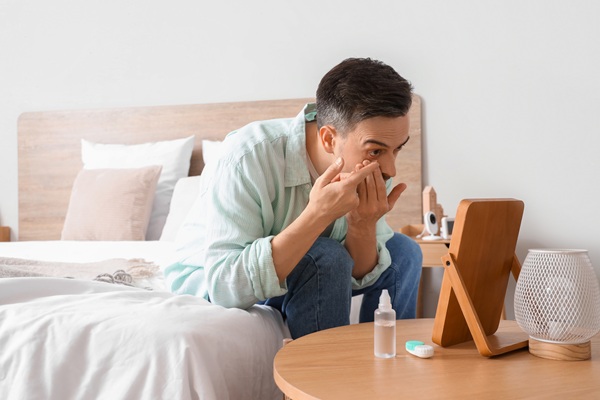What To Expect During a Contact Lens Exam

A contact lens exam is slightly different from an eyeglass prescription exam. Though both correctives are great for helping you see clearly, contact lenses can be a better fit for certain individuals, such as those who live more active lifestyles. Take a closer look at what you can expect during your upcoming examination.
A Complete Guide to the Contact Lens Exam
A general eye exam is a comprehensive assessment of your eye health, while a contact lens exam is a precision-based procedure. Our team conducts a series of specific tests to measure your eye and determine the exact prescription needed for your contact lenses. This ensures a perfect fit and optimal vision correction.
Tests during the contact lens exam
Since contact lenses are foreign objects that patients must insert into their eyes daily, we must ensure they provide a comfortable fit. These ultra-thin lenses, comprising polymer- or silicone-hydrogel, will sit on the cornea or the outer surface of the eye. An improper fit can lead to blurred vision, discomfort, and irritation. Per the Optometrists Network, they can even increase the risk of corneal abrasion or infection. Therefore, we will take our time to determine the measurements for the prescription, corneal shape, size, curvature, and the quality of the patient's tears.
In order to receive accurate information, we will likely conduct the following:
Corneal topography test
This portion of the contact eye exam provides a detailed view of the cornea. We can evaluate the health of the cornea's surface by analyzing how well light emits from a keratometer or corneal topographer. We can also determine if the patient has astigmatism, making them a candidate for a special type of lens called a toric lens.
The test involves the patient sitting in front of a lit bowl containing patterned rings while resting their head on a curved bar. We will then collect data points, and a color-coded map or image of the shape of the cornea will be generated on our computer screens.
Pupillary exam
A pupillary exam is often called the PERRLA test, an acronym for pupils, equal, round, reactive, light, and accommodation. Its primary purpose is to measure the size of the pupil and iris to determine the correct size of lens needed and how reactive the pupils are. It involves using several objects, such as a flashlight to check reactiveness and a ruler or card containing various pupil sizes to get a close size match.
Tear film evaluation
This portion of the contact exam determines the patient's eligibility for lenses. Contact lenses need to stay moist. Therefore, we must ensure the patient's tear production is up to par, as contact lenses can lead to dry eye. Dry eye syndrome is a condition that can cause the eyes to become irritated and itchy, making patients constantly touch or rub them or completely forgo them altogether.
This evaluation involves placing a special strip of material under the lower eyelid. Patients must close their eyes for a minimum of five minutes so that we may harvest their tears on the material. We then measure the amount of tears produced in this time span. We may also perform another test using special eye drops containing fluorescein dye. The aim is to determine how long it takes the patient's tears to evaporate.
Types of contact lenses
After evaluating the information, the optometrist will choose between one of the following types of contact lenses approved by the U.S. Food and Drug Administration or FDA:
- Disposable contact lenses
- Extended wear contact lenses
- Soft contact lenses
- Rigid gas permeable (RGP) contact lenses
The patient will likely receive a trial pair of contact lenses to ensure a proper fit. It is not uncommon for patients to receive more than one trial pair before receiving their permanent contact lenses. It is also important to mention that most patients will not receive their contact lenses the same day as their evaluation because they need to be crafted in an offsite location. However, they will have access to their prescription and measurements upon request.
Follow-up appointments
We strongly recommend attending a follow-up appointment after receiving permanent contact lenses. Our primary concern is ensuring that the lenses do not physically change the structure of the eyes. This appointment will involve another exam. However, it will be much quicker than the initial contact lens exam.
We perform a slit lamp exam, which involves using an instrument called a slit lamp to examine the cornea and other soft tissues within the eye. It can also evaluate how well the lenses fit, especially after being used for a while. We may also employ the same fluorescein dye-infused eye drops used during the tear film evaluation check for corneal damage. Of course, if the patient is experiencing increased blurred vision or discomfort after receiving the new lenses and before their follow-up, they should give us a call.
Undergo a contact lens exam in the Dallas area
A comprehensive contact lens exam can help us evaluate the needs of your eyes. If you are interested in receiving corrective lenses and live in or around the Dallas area, give Texas Optical a call.
Request an appointment here: https://www.texasoptical.net or call Texas Optical at (214) 771-7333 for an appointment in our Dallas office.
Check out what others are saying about our services on Yelp: Read our Yelp reviews.
Recent Posts
Prescription contacts provide vision correction, comfort, and convenience for those who do not want to wear glasses. However, caring for and wearing contacts takes some getting used to. Learning to insert, remove, and maintain them will help ensure a comfortable and safe experience.Not all contact lenses are the same, and choosing the right pair is…
If you are thinking about seeing an optometrist, you should first look at your options. When you understand what this doctor does, you can make the right choice for your eye health. Other medical professionals help patients with their eyes too. So, it is important that you get the relief and treatment you need.People depend…
With digital screens occupying the majority of our lives, concerns about eye strain and potential long-term effects have increased the popularity of blue light glasses. Many individuals who spend extended hours in front of screens in their personal and professional lives seek practical solutions to alleviate symptoms associated with prolonged exposure to artificial lighting. Fortunately,…
Visiting an optometrist for a vision test is an important first step in protecting one of your most valuable assets —your eyesight. A professional assessment is key whether you are concerned about changes in your eyesight or addressing potential eye health issues. Discover the many benefits of scheduling a vision test and how it can…


